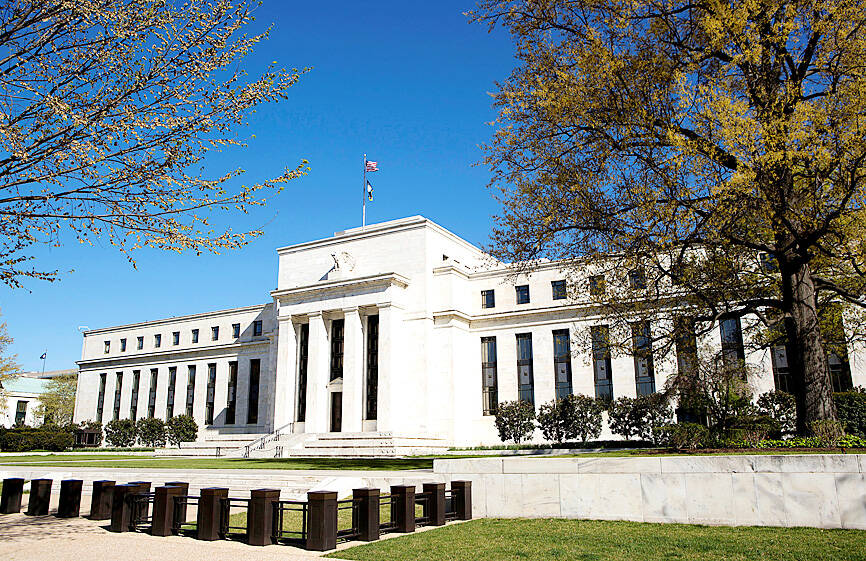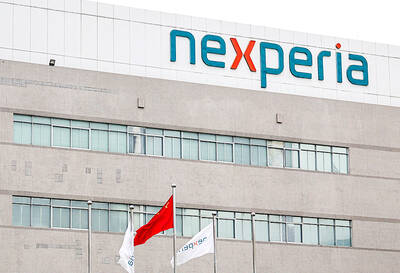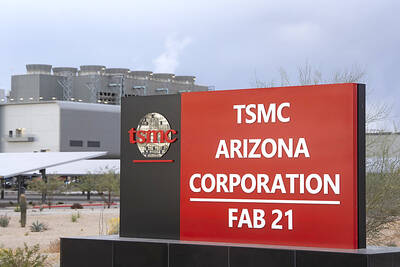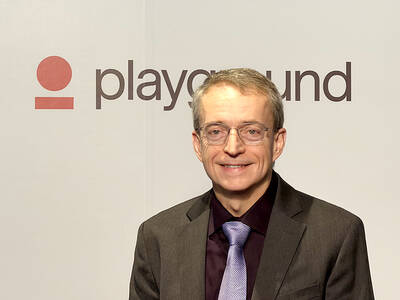Investors might glean more on the Fed’s resolve to ease and how close Japan is to finally exiting negative interest rates as central banks set policy for almost half the global economy.
This week features the world’s biggest collection of decisions for this year to date, including judgements on the cost of borrowing for six of the 10 most-traded currencies. The collective outcome might underscore how monetary officials’ perception of inflation risks is diverging noticeably.
The Bank of Japan’s (BOJ) announcement tomorrow is pivotal.

Photo: Reuters
It might finally move toward raising borrowing costs and effectively calling an end to a generation-long period of feeble price growth points.
The meeting comes days after Japan’s largest umbrella group for unions announced that annual pay negotiations resulted in the biggest increases in more than 30 years, sending a signal to authorities that their long-sought-after virtuous cycle of strong wages fueling demand-led inflation might be emerging.
“We think it will judge that it’s too early to tighten,” Bloomberg Economics senior Japan economist Taro Kimura said in a report. “To be sure, there is a significant risk to our call.”
On the same day, the Reserve Bank of Australia is expected to hold its cash rate at 4.35 percent after weaker-than-expected inflation in January. Investors would focus on whether the institution keeps its hawkish tone or hints at a pivot a few months out.
Most consequential would be the Fed’s decision on Wednesday. The US central bank is widely expected to hold rates steady for a fifth consecutive meeting and to continue to project three quarter-point rate cuts this year, even as inflation has proven stickier than expected in the past two months.
After raising their benchmark federal funds rate by more than five percentage points starting in March 2022, the Federal Open Market Committee has held borrowing costs at a two-decade high since July last year.
Against the backdrop of strong job growth and a jump in prices in January and last month, officials have repeatedly emphasized they are in no rush to ease.
US Federal Reserve Chairman Jerome Powell told US Congress this month that the central bank is getting close to the confidence it needs to start lowering rates, saying they were “not far” from that when considering the strength of inflation.
The central bank in Taiwan last week hinted it might keep interest rates unchanged in its quarterly board meeting this Thursday, while raising concern about the impact the government’s proposed electricity price increases could have on inflation.
“There is no room for rate cuts before June,” central bank Governor Yang Chin-long (楊金龍) told lawmakers.
When asked whether the monetary authority would consider increasing borrowing costs to curb inflation, he said it would “cautiously discuss the possibility of rate hikes in its board meeting next week.”
The central bank raised its inflation forecast for this year to 1.89 percent in December last year, when it kept borrowing costs at 1.875 percent for the third straight meeting.
Yang last week said the central bank could increase its inflation forecast to factor in new electricity prices.
In Europe, central banks from the UK to Switzerland might inch toward reducing borrowing costs.
The Swiss National Bank is anticipated by most economists to stay on hold on Thursday, though two respondents in Bloomberg’s survey predicted that officials would cut rates, opting not to wait for bigger counterparts to start their own easing cycles.
Shortly after that, Norges Bank is also expected to keep borrowing costs on hold, with investors focusing on potential changes in its outlook for when reductions might start.
Meanwhile, Bank of England policymakers would have fresh inflation data on Wednesday and the latest purchasing manager surveys on Thursday to consider before their decision, which is seen likely to keep rates unchanged again.

JITTERS: Nexperia has a 20 percent market share for chips powering simpler features such as window controls, and changing supply chains could take years European carmakers are looking into ways to scratch components made with parts from China, spooked by deepening geopolitical spats playing out through chipmaker Nexperia BV and Beijing’s export controls on rare earths. To protect operations from trade ructions, several automakers are pushing major suppliers to find permanent alternatives to Chinese semiconductors, people familiar with the matter said. The industry is considering broader changes to its supply chain to adapt to shifting geopolitics, Europe’s main suppliers lobby CLEPA head Matthias Zink said. “We had some indications already — questions like: ‘How can you supply me without this dependency on China?’” Zink, who also

The number of Taiwanese working in the US rose to a record high of 137,000 last year, driven largely by Taiwan Semiconductor Manufacturing Co’s (TSMC, 台積電) rapid overseas expansion, according to government data released yesterday. A total of 666,000 Taiwanese nationals were employed abroad last year, an increase of 45,000 from 2023 and the highest level since the COVID-19 pandemic, data from the Directorate-General of Budget, Accounting and Statistics (DGBAS) showed. Overseas employment had steadily increased between 2009 and 2019, peaking at 739,000, before plunging to 319,000 in 2021 amid US-China trade tensions, global supply chain shifts, reshoring by Taiwanese companies and

Taiwan Semiconductor Manufacturing Co (TSMC, 台積電) received about NT$147 billion (US$4.71 billion) in subsidies from the US, Japanese, German and Chinese governments over the past two years for its global expansion. Financial data compiled by the world’s largest contract chipmaker showed the company secured NT$4.77 billion in subsidies from the governments in the third quarter, bringing the total for the first three quarters of the year to about NT$71.9 billion. Along with the NT$75.16 billion in financial aid TSMC received last year, the chipmaker obtained NT$147 billion in subsidies in almost two years, the data showed. The subsidies received by its subsidiaries —

OUTLOOK: Pat Gelsinger said he did not expect the heavy AI infrastructure investments by the major cloud service providers to cause an AI bubble to burst soon Building a resilient energy supply chain is crucial for Taiwan to develop artificial intelligence (AI) technology and grow its economy, former Intel Corp chief executive officer Pat Gelsinger said yesterday. Gelsinger, now a general partner at the US venture capital firm Playground Global LLC, was asked at a news conference in Taipei about his views on Taiwan’s hardware development and growing concern over an AI bubble. “Today, the greatest issue in Taiwan isn’t even in the software or in architecture. It is energy,” Gelsinger said. “You are not in the position to have a resilient energy supply chain, and that,